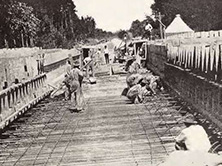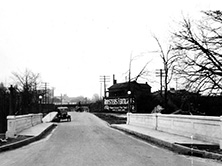 Federal-Aid Project No. 25 under construction in Person County over the North or South Fork of the Flat River between Roxboro and the Durham County line (Fourth Biennial Report of the State Highway Commission, 1919-1920)
Federal-Aid Project No. 25 under construction in Person County over the North or South Fork of the Flat River between Roxboro and the Durham County line (Fourth Biennial Report of the State Highway Commission, 1919-1920) The Federal Aid Road Act of 1916 was the culmination of more than 20 years effort by Good Roads reformers to make the improvement of roads and bridges a nationwide priority.
Congress initially provided $75 million to improve roads and bridges with costs split 50/50 with the states. The cost-sharing arrangement remained basically unchanged until the establishment of the interstate highway program in 1956, when the federal share was increased to 90/10 for the expensive, high-speed, long-distance thoroughfares.
The Federal Aid Highway Program remains one of the hallmark examples of federalism, with authority shared between the states and Washington. The act required each state to have a highway department with professional engineers to direct the work.
North Carolina established its State Highway Commission in 1915. Although originally intended to offer technical advice to counties, the Commission’s business soon came to be dominated by federal aid road and bridge work.
 Federal-Aid Project No. 691 helped the State Highway Commission construct two 35-foot-long, reinforced concrete through girder spans over Bearskin Creek in Monroe in 1923 (Courtesy of The State Archives of North Carolina) The political and organizational change promoted by the Federal Aid Road Act of 1916 and its subsequent reauthorizations had a profound impact on highway and bridge building in North Carolina and the nation. Not only did it mean increased funding for roads and bridges, but it promoted standardization of design at the state level.
Federal-Aid Project No. 691 helped the State Highway Commission construct two 35-foot-long, reinforced concrete through girder spans over Bearskin Creek in Monroe in 1923 (Courtesy of The State Archives of North Carolina) The political and organizational change promoted by the Federal Aid Road Act of 1916 and its subsequent reauthorizations had a profound impact on highway and bridge building in North Carolina and the nation. Not only did it mean increased funding for roads and bridges, but it promoted standardization of design at the state level.
Importantly, standards were specifically identified as a state concern. Federal engineers would only inspect and approve state decisions, leaving the actual design and construction to state engineers. Thus, the North Carolina State Highway Commission's engineers adopted their own construction, materials, and bridge specifications.
These were often patterned after or directly referenced national guidelines, but were adaptable to North Carolina's topography, transportation patterns, political realities, and the state engineers' preferences. State bridge engineers developed their own methods of solving construction problems within the latitude given them by the federal aid program.
Many of North Carolina's historic bridges represent the work of state engineers and their significant contributions to safer and more efficient highways from the late 1910s through the 1950s and beyond.